Updated: 16-Sep-2024
Around 1909, the Sunbeam Car Company was located in Moorfield when it began to build aero engines.
-Coinciding with the arrival of a new head of engineering, the Frenchman Louis Coatalen with experience from having been at the Humber (see), Sunbeam was dedicated to the design of sports cars.
-Very soon Mr. Coatalen paid attention to aeronautical advances and decided to enter the field of aero engines.
-First with two types of engines, a V8 and a V12. Built from scratch despite having apparent analogies with other engines.
-Due to this designer, the brand's aero engines are known as "Sunbeam-Coatalen".

“Sunbeam Crusader”
-It seems that the first design was the “Crusader” engine, in 1912.
-Starting with 110 HP, it went up to 120 at 2,500 rpm, eventually reaching 150 HP.
-With side valves, located in the block, it was the first of four engines of this type: the Crusader, the Mohawk, the Zulu and the Ghurka.
-It is mentioned in a publication that an engine of this type went to pre-revolutionary Russia where it would be manufactured by the Russian-Baltic Railway Material Company, as R-BVZ.
-As we will see, the Sunbeam engines were named after warriors from different ethnic groups in the world.
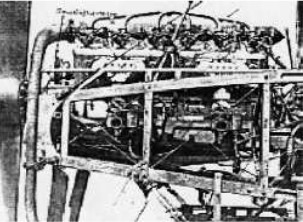
“Installation of a Sunbeam Mohawk”
-The “Mohawk” was a 12-cylinder V-engine with side valves, starting with 200 HP and going up to 225. Sometimes known as the Sunbeam 225.
-It appeared in 1914 and continued to be manufactured until 1918, with around 280 units delivered.
-It had a 0.5 to 1 reduction gear, and it could be installed as a push or pull unit.
-The “Zulu” was a version similar to the Crusader, which it was intended to replace on existing aircraft. They are from 1915 giving 160 HP at 2,000 rpm.
-They had 8 cylinders in V and reduction gear.
-We move on to the “Ghurka”, the last engine of this group with side valves.
-It was built at the same time as the Zulu and with the intention of replacing the Mohawk.
-It seems that the last Ghurka can be seen at the Yeovilton Fleet Air Arm Museum.
-The Ghurka's power was 240 hp at 2,000 rpm. It had twelve cylinders at a 60° V.
-From this moment on, side-valve engines were no longer manufactured and instead they switched to overhead valves. And here is a long list of engines:
-The Cossack, Nubian, Afridi, Maori, Amazon, Viking, Arab, Bedouin, Manitou, Saracen, Spartan, Matabele, Tartar, Kaffir, Malay, Dyak, Sikh, Half-Sikh, Pathan, P.1.
-The 12V Cossack was developed from the Amazon, with four valves per cylinder. It was water cooled and had reduction gear. It delivered 320 HP.
-This was considered a Sunbeam success and the Cossack I, II and III were also made. The latter was used on several British airships such as the R.36, R.37 and R.38 of the Short Brothers.
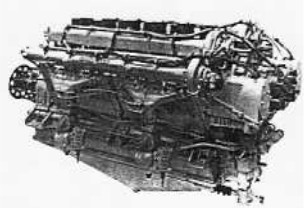

“Cossack”
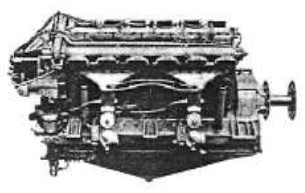
“Cossack II”
-The four magnetos at the rear stand out, two for each row of cylinders.

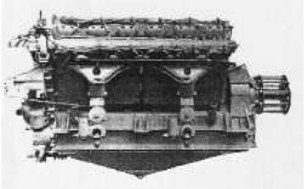
“Two views of the Cossack III”
-The Cossacks were programmed for 320 HP but reached 350 HP in the later versions.
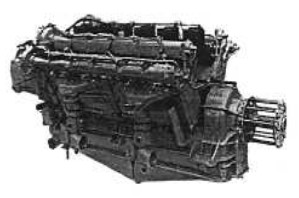
“Cossack, right front side”
-It is known that the “Nubian” was based on a Peugeot sports-car engine from 1913.
-Work on it was already started in 1916. It was a V-8 engine that gave 155 HP.
-There were design and delivery problems, so it was replaced by Hispano-Suiza engines on the aircraft it was intended for.


“Sunbeam-Coatalen Nubian”
-The 36 delivered engines went to English aircraft such as the Avro 510, 523 and 527, the Blackburn Seaplanes, Saunders T1, Short C, Sopwith 806 Gunbus, etc.
-The “Afridi” was the second V-12 engine designed by Coatalen and with its overhead valves it was intended to replace the side-valve engines such as the Zulu and Crusader. It gave 200 HP and had 4 valves per cylinder.
-It started with 200 HP at 2,000 rpm. Delivery began in 1916 and with increased displacement the engine delivered 260 HP.
-After this increase in power and other slight modifications the 260 HP engine was renamed “Maori”.
There were several versions of this engine, as we will see.

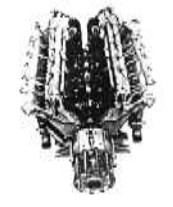
“Sunbeam Maori”
-The Maori was manufactured between 1914 and 1918, and almost 1,000 units were built. They were fitted on Short-184 and -N2B aircraft.
-The Maori II, similar to the I, was installed on many more aircraft, especially Faireys.
-The Maori III, like the II, gave different power outputs during bench tests, as we can see in the sheets of the time.
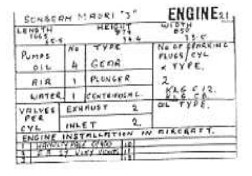
“Bench test of the Maori III, first sheet”

“Results of a bench test of the Maori III, second sheet”
So we see that the nominal power was stipulated at 250 HP, rising the revolutions to 2,100 rpm, the power is 270 HP and reaching 2,200 rpm, it rises to 284 HP.

“Schematic drawing of the Maori 4”
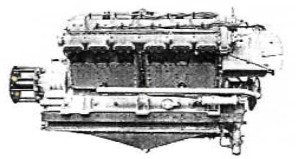
“Sunbeam-Coatalen Maori 4”
-The Maori 4 is already from 1919, after the war, giving 250 HP and with a 2 to 1 reduction gear. It had two rocker shafts per head and four valves per cylinder.
-They were installed on the first R.33, a dirigible of the English Navy and also on the R-34 (later they would be powered by Armstrong-Siddeley and Beardmore respectively. There were 5 engines on the R-33-).
-The “Amazon” engines were 6-cylinder in-line engines. They were considered “half” a Cossack. The first models gave 160 HP, which increased to 170/190 HP with later models. They are from 1917.
-It seems that a certain number were supplied to the Russian Air Service.
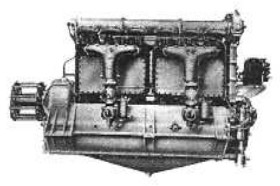
“Sunbeam Amazon”
-Looking at the following figure of an Amazon rear-view we see the similarity with a line of cylinders of the Cossack, on which it is based.
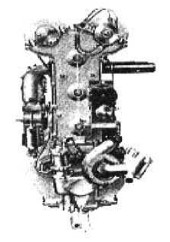
“Rear view of the Amazon”
-The “Viking” belongs to the Cossack family although of a completely new design as it had 18 W-shaped cylinders, in three rows of 6 cylinders.

“Sunbeam-Coatalen, Viking”
-It gave 450 HP at 1,800 rpm, and it had six magnetos, two for each cylinder row. The first engine was delivered in 1917.
-We come to another important Sunbeam-Coatalen engine, the “Arab”.
-The Arab was a V-8 in the initial 200 HP range. Several versions were made, including with reduction gear.
-The Arab prototype had direct propeller drive. The one in the below illustration gave 235 HP at 2,000 rpm.

“Arab, 235 HP, direct output”
-The Arab I, continued with the direct propeller output. Built mostly in aluminum.

“Sunbeam Arab I”
-Below we see another Arab, possibly an Arab II with reduction gear and exhausts.
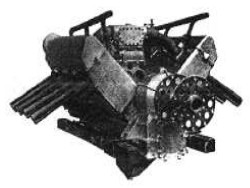
“Arab 2, with reduction gear and exhausts”
-For comparison, four views of the Arab 2, or Arab II, are presented.
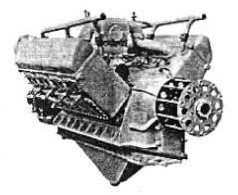

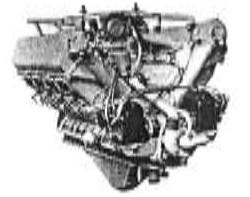

“Four Arab 2 or II engines”
-In total, more than 2,100 Arab engines were made between those made in the USA by Willys Overland and the British Napier, Lanchester y Austin Motors.
-The Arabs with reduction gear had the crankshaft rotating at 2,000 rpm and the propeller at 1,200 rpm.
-The “Bedouin” engine was an Arab in an inverted V version, with an overhead camshaft operating three valves per cylinder: 1 intake and two exhaust valves. It gave 200 HP at 2,000 rpm.
-The “Manitou” engines of 1917 (as we see in these early years and during WWI, they were very prolific at Sunbeam), were in the order of 300 HP, with 12 cylinders in a 60° V.
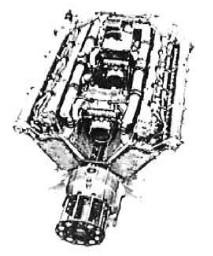
“Sunbeam-Coatalen, Manitou”
-It is mentioned that the Manitou was a development from the Maori, specifically the Maori III with an increase of large aluminum parts instead of cast iron. Later the steel cylinders would be pressed into the aluminum block. Although this already occurred with the Maori 4.
-The 300 HP were obtained at 2,000 rpm. Later it would reach 325 HP.
-It had a reduction gear with 28 to 44 teeth on the gears, giving a ratio of 0.636 : 1. It could be installed in a puller or pusher position.
-It also had a Claudel-Hobson carburetor and BTH magnetos.
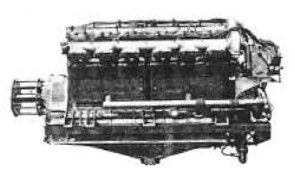
“Manitou, left side view”

“Manitou, top rear view”
-The “Saracen” was a later development of the Amazon with a bit more displacement. It was presented to the English Aeronautics Committee but was considered outdated. It gave 200 HP at 2,000 rpm with its six in-line cylinders.
-Another engine was an attempt to build an air-cooled V12, a decision almost entirely by Louis Coatalen. But its power was not related to its displacement and it did not go into production. It gave 200 HP with about 14 liters of displacement.
-We come to the Matabele from 1918, it had the cylinder blocks of the Saracen. Although it had details of the Cossack, it had the parts built in aluminum instead of cast iron.
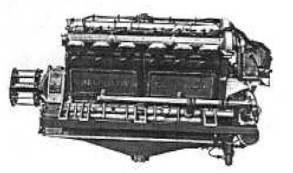
“Matabele, 420 HP”
-Other versions pair it with the Amazon. On the side covers of the cooling water chambers we can see the letters “Sunbeam-Coatalen”, that is, the combination of the English brand Sunbeam with the designer Louis Hervé Coatalen.

“Matabele”
-It is a 12-cylinder 60° V engine giving 400 HP at 2,000 rpm.
-The cylinder had dimensions of 122 mm bore and 160 mm stroke, giving a total displacement of 22.45 l.
-They had double overhead camshafts controlling four valves per cylinder.
-They had two Claudel-Hobson HC-7 carburetors, four magnetos, and reduction gear at a 1.63 to 1 ratio.
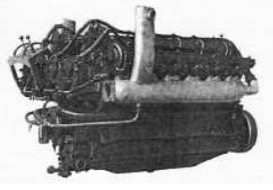
“Matabele, 430 HP”
-The small dampener or front flywheel -or rear depending on how you look at it-, as well as the heavy protected exhaust, indicate that this Matabele was more intended for nautical use or at best for an airship.
-Matabele engines were also used to break land records, such as the record obtained in Daytona Beach, Florida, with the 1000 HP Sunbeam (two Matabele engines on the same chassis) and reaching a little over 200 mph.
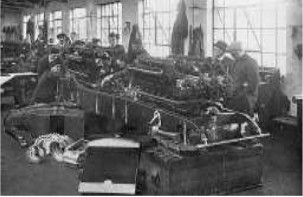
“Sunbeam 1000 hp production”
-The two engines were facing each other, one at the front and the other at the rear.
-In 1917 there was an engine specially designed for dirigibles, but it remained experimental and did not go into production. It was the “Tartar”, a 300 HP V12.
-The “Kaffir” engine also gave 300 HP, but with 12 W-shaped cylinders. It had 18.33 liters of displacement. and only remained a prototype.
-The “Malay” was another story. It was an engine with 5 blocks of 4 cylinders placed radially around a crankcase, with a total displacement of almost 30 liters.
-It was calculated to reach 500 HP, but only prototypes were made and it never went into production.
-Now we come to the description of the “Dyak”, a water-cooled, six-cylinder, in-line engine.
-In a Sunbeam-Coatalen ad we see the Dyak in the foreground for several of its aero engines.
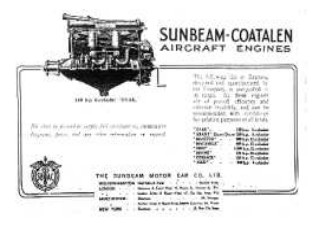
“Sunbeam-Coatalen ad”
-It had two Claudel Hobson carburetors (BZS.38) and ML magnetos.
-They gave around 100 HP. These engines have a monoblock with large side and front covers, removable for inspection and cleaning.
-Below we provide three views, one rear, one front and a side view. The crank start at the rear of the engine is curious. The water pump is at the lowest point and we observe the water exiting above the cylinder heads in a pronounced “ramp” towards the radiator.
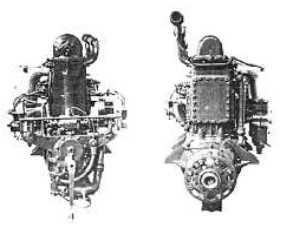
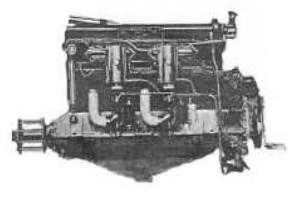
“Three views of the Dyak engine”
-Now we come to the “Sikh”. From Sikh I to III.
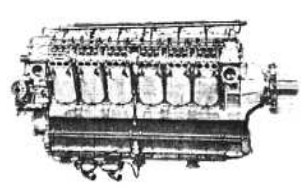
“Sunbeam-Coatalen Sikh I”
-Compared to the other Sunbeams, the Sikhs were large engines, from 800 to 1,000 HP.
-The Sikhs were designed at the end of 1918, they had a displacement of 64.1 liters, in their 12 V cylinders.
-If we look at the cylinder heads, there are three holes for the exhaust, that is, there were three exhaust valves. In total there were six valves per cylinder head.

“Sikh”
-The intake was made through the manifolds located in the center of the V formed by the cylinders. The carburetors were also there. At the rear there are the two magnetos and some tubes go from the cylinders to the water pumps under the engine.
The Sikh I, obtained the 800 HP at 1,400 rpm and with the reduction gear the propeller rotated at 920 rpm.
-The Sikh III was an engine intended to be installed on airships such as the R-100 and R-101.
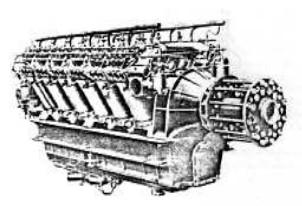
“Sikh III”
-The Sikh III reached 1,000 HP at 1,650 rpm. It had 5 valves per cylinder head. They were not fitted on airships and remained in prototypes.
-Interestingly, the Sikh II was a half Sikh engine, using only one line of cylinders, the “Half-Sikh” or “Sikh II” was made for airships as well.
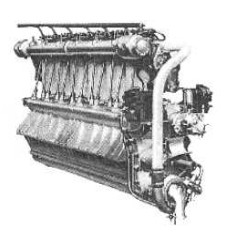
“Half-Sikh”
-Based on the Dyak, Coatalen tested its first Diesel, the “Pathan” or Type P.1. It gave 100 HP at 1,500 rpm, it used a new type of injection pump compared to the known ones.
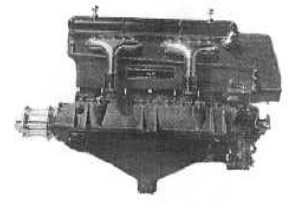
“Sunbeam-Coatalen Pathan”
-This was in 1928-1929. It was also intended for coastal airships, but the British Airship Program was canceled and no engine could be fitted.
-Finally Louis Hervé Coatalen decided to return to France where he began to design and build his own engines, see Coatalen.
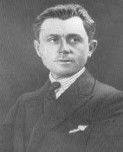
“Louis H. Coatalen”
-We have two ads for the Sunbeam brand engines.
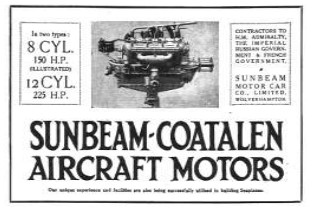
“Sunbeam-Coatalen ad from 1916”
-And another earlier one, from 1915, where the Sunbeam Motor Cars aviation-engine factory is shown.
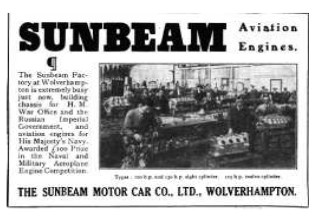
“Sunbeam ad from 1915”
-As we can see, with the difference of one year, the name of Sunbeam appears in relation to Coatalen, the famous French engineer.
The engines that came from the Chalais-Meudon test center, as well as other later contributions are preserved at the reserves of the MAE (Air and Space Museum of Le Bourget), north of Paris.

“Rear view of a Sunbeam at the MAE”
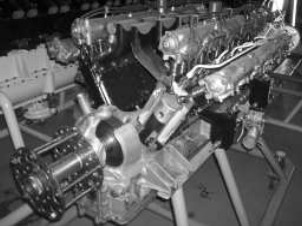
“The same engine seen from the front”
-This engine is a cutaway for educational purposes. But we can see that the magnetos are enclosed in pairs in protective boxes behind the engine.
-Each pair of magnetos feeds its line of cylinders. It is clearly a V-12.
-Another photograph is shown of the so-called Sunbeam-Coatalen because it was designed by the French engineer Coatalen.
-It is the Viking model, although from the main chapter we know that he designed a wide range of models.

“Sunbeam Coatalen, Viking”
-Sunbeam and Talbot collaborate on the 4-cylinder inline engine. An existing photograph has been requested from NASM under the code (BS-300260-20).
From Appendix A1/6: In 1914 Sunbeam showed its 150 HP engine.
-At that time the company was called “Sunbeam Motor Car Co. Ltd.”. This V-8 engine was presented to a military competition, and a later V12 version would give 225 HP.
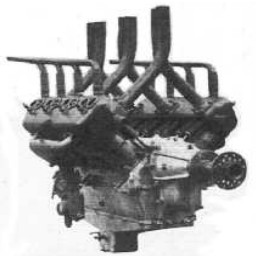
“Sunbeam. 150 HP”
-Below we show the Subeam Diesel engine, model P.I. in a 3/4 rear view.
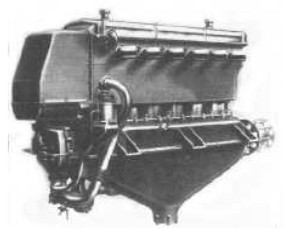
“Sunbeam P.I. 100 HP at 1,500 rpm”
From Appendix 9: There is a slightly mutilated engine at the Krakow museum. This is the Sunbeam Mohawk.
-Spark plugs and ignition ramps are missing and the outer manifolds are broken due to the plates that hold them to the blocks.
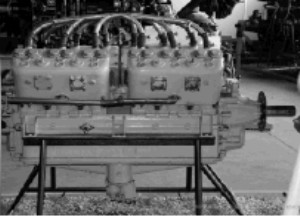
“Sunbeam Mohawk”
-But what is most striking about this engine is that the cylinder blocks on both sides are not aligned, or even out of phase in groups of 6 cylinders, but the blocks on the left side are together while those on the right are separated. See photo.
-This seems to indicate that there are no fork-type connecting rods or articulated connecting rods.
From Appendix 10: Below we show two unpublished photographs of the Sunbeam “Sikh III”.

“Sikh II, right side view”

“Sikh III from behind and manual starter crank"
Engines of SUNBEAM
Model: 110 HP
Arquitecture:
Cooling:
Total Displacement:
Bore / Stroke: x
Power:
Weight:
Model: 150 HP
Arquitecture:
Cooling:
Total Displacement:
Bore / Stroke: x
Power:
Weight:
Model: 200 HP
Arquitecture:
Cooling:
Total Displacement:
Bore / Stroke: x
Power:
Weight:
Model: 225 HP
Arquitecture:
Cooling:
Total Displacement:
Bore / Stroke: x
Power:
Weight:
Model: 3-cylinder fan-shape
Arquitecture:
Cooling:
Total Displacement:
Bore / Stroke: x
Power:
Weight:
Model: Afridi
Arquitecture:
Cooling:
Total Displacement:
Bore / Stroke: x
Power:
Weight:
Model: Amazon
Arquitecture:
Cooling:
Total Displacement:
Bore / Stroke: x
Power:
Weight:
Model: Arab
Arquitecture:
Cooling:
Total Displacement:
Bore / Stroke: x
Power:
Weight:
Model: Bedouin
Arquitecture:
Cooling:
Total Displacement:
Bore / Stroke: x
Power:
Weight:
Model: Cossack
Arquitecture:
Cooling:
Total Displacement:
Bore / Stroke: x
Power:
Weight:
Model: Crussader
Arquitecture:
Cooling:
Total Displacement:
Bore / Stroke: x
Power:
Weight:
Model: Dyak
Arquitecture:
Cooling:
Total Displacement:
Bore / Stroke: x
Power:
Weight:
Model: Gurkha
Arquitecture:
Cooling:
Total Displacement:
Bore / Stroke: x
Power:
Weight:
Model: Kaffir
Arquitecture:
Cooling:
Total Displacement:
Bore / Stroke: x
Power:
Weight:
Model: Malay
Arquitecture:
Cooling:
Total Displacement:
Bore / Stroke: x
Power:
Weight:
Model: Manitou
Arquitecture:
Cooling:
Total Displacement:
Bore / Stroke: x
Power:
Weight:
Model: Maori
Arquitecture:
Cooling:
Total Displacement:
Bore / Stroke: x
Power:
Weight:
Model: Matabele
Arquitecture:
Cooling:
Total Displacement:
Bore / Stroke: x
Power:
Weight:
Model: Mohawk
Arquitecture:
Cooling:
Total Displacement:
Bore / Stroke: x
Power:
Weight:
Model: Nubian
Arquitecture:
Cooling:
Total Displacement:
Bore / Stroke: x
Power:
Weight:
Model: P-1
Arquitecture:
Cooling:
Total Displacement:
Bore / Stroke: x
Power:
Weight:
Model: Pathan
Arquitecture:
Cooling:
Total Displacement:
Bore / Stroke: x
Power:
Weight:
Model: Saracen
Arquitecture:
Cooling:
Total Displacement:
Bore / Stroke: x
Power:
Weight:
Model: Semi-Sikh
Arquitecture:
Cooling:
Total Displacement:
Bore / Stroke: x
Power:
Weight:
Model: Sikh, II, III
Arquitecture:
Cooling:
Total Displacement:
Bore / Stroke: x
Power:
Weight:
Model: Spartan
Arquitecture:
Cooling:
Total Displacement:
Bore / Stroke: x
Power:
Weight:
Model: Tartar
Arquitecture:
Cooling:
Total Displacement:
Bore / Stroke: x
Power:
Weight:
Model: Viking
Arquitecture:
Cooling:
Total Displacement:
Bore / Stroke: x
Power:
Weight:
Model: Zulu
Arquitecture:
Cooling:
Total Displacement:
Bore / Stroke: x
Power:
Weight:


